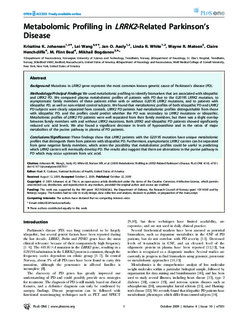| dc.contributor.author | Johansen, Krisztina | |
| dc.contributor.author | Wang, Lei | |
| dc.contributor.author | Aasly, Jan | |
| dc.contributor.author | White, Linda | |
| dc.contributor.author | Matson, Wayne R. | |
| dc.contributor.author | Henchcliffe, Claire | |
| dc.contributor.author | Flint Beal, M. | |
| dc.contributor.author | Bogdanov, Mikhail | |
| dc.date.accessioned | 2015-10-29T13:33:59Z | |
| dc.date.accessioned | 2015-12-10T15:09:30Z | |
| dc.date.available | 2015-10-29T13:33:59Z | |
| dc.date.available | 2015-12-10T15:09:30Z | |
| dc.date.issued | 2009 | |
| dc.identifier.citation | PLoS ONE 2009, 4(10) | nb_NO |
| dc.identifier.issn | 1932-6203 | |
| dc.identifier.uri | http://hdl.handle.net/11250/2367519 | |
| dc.description.abstract | Background:
Mutations in LRRK2 gene represent the most common known genetic cause of Parkinson's disease (PD).
Methodology/Principal Findings:
We used metabolomic profiling to identify biomarkers that are associated with idiopathic and LRRK2 PD. We compared plasma metabolomic profiles of patients with PD due to the G2019S LRRK2 mutation, to asymptomatic family members of these patients either with or without G2019S LRRK2 mutations, and to patients with idiopathic PD, as well as non-related control subjects. We found that metabolomic profiles of both idiopathic PD and LRRK2 PD subjects were clearly separated from controls. LRRK2 PD patients had metabolomic profiles distinguishable from those with idiopathic PD, and the profiles could predict whether the PD was secondary to LRRK2 mutations or idiopathic. Metabolomic profiles of LRRK2 PD patients were well separated from their family members, but there was a slight overlap between family members with and without LRRK2 mutations. Both LRRK2 and idiopathic PD patients showed significantly reduced uric acid levels. We also found a significant decrease in levels of hypoxanthine and in the ratios of major metabolites of the purine pathway in plasma of PD patients.
Conclusions/Significance:
These findings show that LRRK2 patients with the G2019S mutation have unique metabolomic profiles that distinguish them from patients with idiopathic PD. Furthermore, asymptomatic LRRK2 carriers can be separated from gene negative family members, which raises the possibility that metabolomic profiles could be useful in predicting which LRRK2 carriers will eventually develop PD. The results also suggest that there are aberrations in the purine pathway in PD which may occur upstream from uric acid. | nb_NO |
| dc.language.iso | eng | nb_NO |
| dc.publisher | Public Library of Science | nb_NO |
| dc.title | Metabolomic profiling in LRRK2-related Parkinson's disease | nb_NO |
| dc.type | Journal article | nb_NO |
| dc.type | Peer reviewed | en_GB |
| dc.date.updated | 2015-10-29T13:33:59Z | |
| dc.source.volume | 4 | nb_NO |
| dc.source.journal | PLoS ONE | nb_NO |
| dc.source.issue | 10 | nb_NO |
| dc.identifier.doi | 10.1371/journal.pone.0007551 | |
| dc.identifier.cristin | 344053 | |
| dc.description.localcode | © 2009 Johansen et al. This is an open-access article distributed under the terms of the Creative Commons Attribution License, which permits unrestricted use, distribution, and reproduction in any medium, provided the original author and source are credited. | nb_NO |
